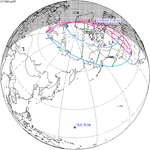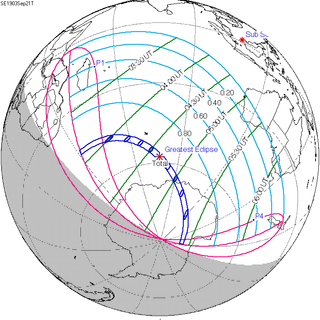Solar eclipse of September 21, 1903
| Solar eclipse of September 21, 1903 | |
|---|---|
| Type of eclipse | |
| Nature | Total |
| Gamma | −0.8967 |
| Magnitude | 1.0316 |
| Maximum eclipse | |
| Duration | 132 s (2 min 12 s) |
| Coordinates | 58°00′S 77°12′E / 58°S 77.2°E |
| Max. width of band | 241 km (150 mi) |
| Times (UTC) | |
| Greatest eclipse | 4:39:52 |
| References | |
| Saros | 123 (47 of 70) |
| Catalog # (SE5000) | 9289 |
A total solar eclipse occurred on September 21, 1903. A solar eclipse occurs when the Moon passes between Earth and the Sun, thereby totally or partly obscuring the image of the Sun for a viewer on Earth. A total solar eclipse occurs when the Moon's apparent diameter is larger than the Sun's, blocking all direct sunlight, turning day into darkness. Totality occurs in a narrow path across Earth's surface, with the partial solar eclipse visible over a surrounding region thousands of kilometres wide.
Related eclipses
Solar eclipses 1902-1907
This eclipse is a member of a semester series. An eclipse in a semester series of solar eclipses repeats approximately every 177 days and 4 hours (a semester) at alternating nodes of the Moon's orbit.[1]
The partial solar eclipses on May 7, 1902 and October 31, 1902 occur in the previous lunar year eclipse set, and the partial solar eclipse on July 21, 1906 occurs in the next lunar year eclipse set.
| Solar eclipse series sets from 1902 to 1906 | ||||||
|---|---|---|---|---|---|---|
| Descending node | Ascending node | |||||
| Saros | Map | Gamma | Saros | Map | Gamma | |
| 108 | April 8, 1902 Partial |
1.5024 | 113 | October 1, 1902 | ||
| 118 | March 29, 1903 Annular |
0.8413 | 123 | September 21, 1903 Total |
−0.8967 | |
| 128 | March 17, 1904 Annular |
0.1299 | 133 | September 9, 1904 Total |
−0.1625 | |
| 138 | March 6, 1905 Annular |
−0.5768 | 143
|
August 30, 1905 Total |
0.5708 | |
| 148 | February 23, 1906 Partial |
−1.2479 | 153 | August 20, 1906 Partial |
1.3731 | |
Notes
- ^ van Gent, R.H. "Solar- and Lunar-Eclipse Predictions from Antiquity to the Present". A Catalogue of Eclipse Cycles. Utrecht University. Retrieved 6 October 2018.
References
- Earth visibility chart and eclipse statistics Eclipse Predictions by Fred Espenak, NASA/GSFC




